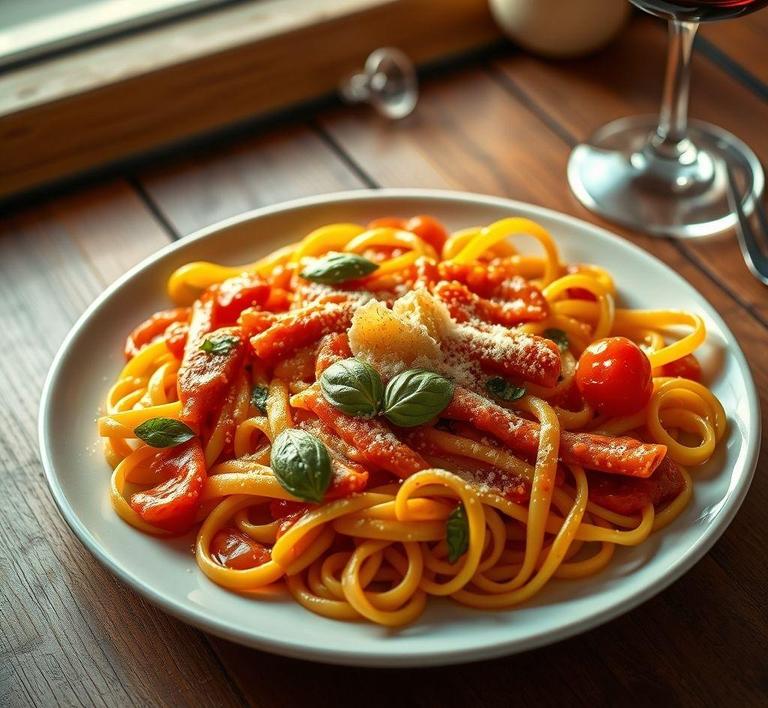Ever found yourself with leftover pasta and wondered if you can refreeze it? The good news is, yes, you can! Refreezing pasta is totally doable, but it’s all about how you do it. Whether it’s spaghetti, penne, or your favorite homemade noodles, you want to make sure it’s stored properly to keep the texture and flavor on point. This guide will walk you through the best methods to safely refreeze pasta, ensuring your next meal tastes just as good as the first time!
Can You Refreeze Pasta?

Pasta, a beloved staple in countless households, is versatile, convenient, and easily stored, which makes it an ideal candidate for meal prepping. But what about refreezing pasta? Is it safe? Will it maintain its quality? These are common questions people ask when they’ve cooked too much pasta or have leftover pasta in the fridge.
First and foremost, the answer to the question "Can you refreeze pasta?" is yes, technically, you can refreeze pasta. However, the real question lies in whether it’s a good idea, and the potential impact on the quality and texture of the pasta. Refreezing is possible because pasta itself doesn’t spoil quickly like some other foods when frozen, but how well it holds up after being frozen and thawed more than once is another matter entirely.
The process of freezing and refreezing pasta can lead to some undesirable changes. For instance, pasta that is frozen and thawed loses its original texture. Over time, the starches in pasta absorb moisture, and refreezing that moisture results in a mushy and overly soft texture. That being said, the biggest risk in refreezing pasta comes from the way it’s prepared-whether it’s mixed with sauce, cheese, or other ingredients. These additional components can affect the final outcome of refrozen pasta, and if not stored properly, it could also risk bacterial growth, making the refreezing process potentially unsafe if the food was not handled properly at each stage.
How To Refreeze Pasta?
If you decide that refreezing pasta is your best option, it’s essential to do it correctly to maximize the chances of preserving its quality as much as possible. Here’s a step-by-step guide on how to refreeze pasta without compromising too much on texture or flavor.
-
Cool the Pasta Properly:
Before freezing, ensure that the pasta has cooled down completely. Leaving pasta at room temperature for an extended period can increase the risk of bacterial growth, which is particularly concerning if you’re planning to refreeze it later. Ideally, you should cool the pasta for no more than two hours before freezing.
-
Separate the Pasta:
If possible, try to freeze the pasta in smaller portions. This makes it easier to thaw only what you need rather than refreezing everything once it has been thawed. You can also place the pasta on a baking sheet in a single layer and freeze it for a few hours before transferring it into a more manageable container. This will prevent the noodles from clumping together.
-
Use Airtight Containers or Freezer Bags:
To avoid freezer burn, place the cooled pasta in airtight containers or freezer bags. Be sure to remove as much air as possible from the bags to maintain the quality of the pasta. If using containers, make sure they are sealed tightly and labeled with the date so you can keep track of how long it’s been stored. When freezing pasta with sauce, be sure the sauce is also well-covered to prevent it from drying out or forming ice crystals.
-
Freezing Time:
Pasta, when properly frozen, can last between 1 and 3 months. Although freezing pasta indefinitely is technically possible, after a few months, you’ll likely start noticing a decline in texture and flavor. If you’re planning to refreeze pasta, try to limit the number of times it’s exposed to freezing and thawing cycles.
-
Thawing the Pasta Before Refreezing:
When you’re ready to refreeze, make sure the pasta is thawed properly before refreezing it. The safest method is to let it thaw in the refrigerator overnight, but if you’re in a hurry, you can also use the microwave or thaw it under running cold water (especially for smaller portions). The key is to never refreeze pasta that has been left at room temperature for too long.
Quality Impact
While you can refreeze pasta, it’s essential to consider how it will affect the final outcome. Refreezing pasta does come with consequences, particularly in terms of quality.
-
Texture Changes:
The biggest change you’ll notice is a decline in texture. Pasta, after being frozen and thawed, tends to lose its firmness and elasticity, becoming soft and mushy upon further freezing and reheating. This is due to the starch molecules that break down during freezing and thawing. Refreezing just amplifies these changes, leaving you with a dish that might not be as enjoyable to eat.
-
Sauce Impact:
If your pasta is mixed with sauce, the quality of both components will be affected. Sauces with high dairy content, like cream-based sauces, may separate or curdle when frozen and thawed. Tomato-based sauces fare better, but they too can lose some of their fresh taste and texture.
-
Flavors Can Deteriorate:
Freezing and refreezing can cause the flavors of the pasta and sauce to dull. The process may also alter the balance of seasonings, making your pasta less flavorful or even bland. The refrozen pasta may not absorb flavors the same way fresh pasta would, and some dishes may taste watered-down or less savory.
-
Moisture Loss and Freezer Burn:
One of the significant threats to frozen pasta is freezer burn. This occurs when moisture evaporates from the pasta due to improper sealing or extended storage. It results in dry spots or discolored areas on the pasta, which will further affect the texture and flavor. Pasta stored for too long or improperly may also lose its inherent moisture, resulting in a dry, rubbery texture when reheated.
-
Safety Considerations:
Although refreezing pasta is generally safe, as long as it’s been stored and thawed properly, there is always a slight risk of bacterial growth if it was improperly handled at any stage. Make sure to follow proper food safety guidelines to reduce any risks. Always make sure the pasta is kept in a clean, airtight environment, and never refreeze anything that’s been left at room temperature for more than two hours.
Refreezing pasta is technically possible, but it comes with trade-offs. While the safety of the practice depends on proper handling, the quality of the pasta is often compromised with each freezing cycle. Refrozen pasta may lose its texture, flavor, and even safety if not done correctly. That said, for those with leftover pasta that they want to store for later use, there are ways to make the process work. However, it’s crucial to be aware that refrozen pasta is best suited for dishes where texture isn’t the primary concern, such as soups, casseroles, or baked pasta dishes.
For the best quality, it’s always a good idea to freeze pasta as soon as it’s cooled, avoid refreezing multiple times, and take care in how it’s stored. By following the right procedures and managing expectations about the quality, you can still make the most out of your refrozen pasta, but don’t expect it to taste like the fresh, al dente version you started with.
Is It Safe To Refreeze Pasta?
Refreezing pasta may seem like a convenient solution to save leftovers or keep a meal ready for later, but it’s a practice that comes with some risks. Whether pasta is cooked or uncooked, refreezing is not always advisable, particularly when it comes to maintaining texture, taste, and overall safety.
When pasta is frozen and thawed, the structure of the starches in the pasta changes. This change can make the pasta softer, mushier, and more prone to breaking apart when reheated. The primary concern with refreezing pasta stems from the quality degradation that occurs each time it is frozen and thawed. The more times pasta is frozen and thawed, the greater the loss of texture and flavor, particularly in pasta dishes with sauces.
From a food safety perspective, refreezing pasta is generally safe if done properly, but the risks arise when the pasta is not handled correctly between freezing and thawing stages. Pasta, like other foods, should be frozen and refrozen within a certain time frame to avoid potential bacterial growth. If the pasta has been at room temperature for too long after the first thaw, refreezing it can increase the risk of foodborne illness.
In short, while it’s technically safe to refreeze pasta as long as it’s been kept at the correct temperatures, it’s best to do so only once, and even then, only if you are certain the pasta has been stored and thawed under safe conditions.
Signs That Pasta Should Not Be Refrozen
Even if you’re inclined to refreeze leftover pasta, there are several signs you should look for to ensure it’s still safe and suitable for refreezing:
- Off Smell or Sour Odor: If the pasta has an unpleasant smell or sour odor, it is a clear indication that it has started to spoil and should not be refrozen. This odor typically indicates bacterial growth, which could lead to foodborne illnesses.
- Discoloration or Mold: Any visible mold or noticeable color changes in the pasta or sauce are immediate signs that refreezing is not safe. Mold can grow on foods that have been left at room temperature too long, and once mold appears, the food is no longer safe to eat, whether frozen or thawed.
- Slimy or Sticky Texture: If the pasta has a slimy or overly sticky texture after being thawed, it may have been exposed to too much moisture or been stored improperly. This change in texture can significantly impact the final dish, making it unpleasant to eat and unsuitable for refreezing.
- Length of Time Left at Room Temperature: If the pasta has been left out at room temperature for more than two hours, it’s unsafe to refreeze. Bacteria multiply quickly at room temperature, and refreezing can allow these bacteria to continue to grow when reheated, posing a health risk.
- Excessive Freezer Burn: If the pasta has been frozen for too long, it can suffer from freezer burn, which is characterized by discolored spots, a dry texture, or an odd taste. Freezer-burned pasta can still technically be eaten, but the quality and texture will be compromised, making refreezing undesirable.
Common Refreezing Mistakes
While it’s possible to refreeze pasta safely, there are a few common mistakes that people often make that can compromise both the safety and quality of the food:
- Not Allowing Proper Thawing Time: One of the biggest mistakes is not allowing pasta to thaw properly before refreezing it. When pasta is rushed through thawing (such as microwaving or leaving it out on the counter), it can begin to sweat, releasing moisture that will freeze and change the texture upon refreezing.
- Refreezing Pasta Multiple Times: Refreezing pasta more than once is a major mistake. Each freeze-thaw cycle impacts the pasta’s texture, flavor, and overall quality. Multiple cycles can turn the pasta into a soggy mess with reduced taste and nutritional value. As a rule of thumb, only freeze pasta once.
- Freezing Pasta with Sauce that Contains Dairy: Sauces with dairy, like Alfredo or cheese-based sauces, do not freeze as well as tomato-based sauces. When these sauces are refrozen and reheated, they can separate, becoming oily or curdled. This can impact the overall appeal of the dish once it is reheated after refreezing.
- Improper Packaging: If pasta isn’t stored in airtight containers or freezer bags, moisture can get trapped and cause freezer burn. This not only affects the pasta’s texture but also leads to a loss of flavor. Proper packaging is crucial for maintaining the quality of frozen pasta.
- Freezing Pasta with Undercooked Elements: If you refreeze pasta that is only partially cooked, especially in a dish that includes meat or seafood, there’s an increased risk of bacterial contamination. Raw ingredients that are frozen and then thawed without being fully cooked can lead to foodborne illnesses if not handled correctly.
Tips And Tricks
Refreezing pasta can be done without sacrificing too much quality if you follow these tips:
- Cool the Pasta Quickly: After cooking, allow pasta to cool as quickly as possible before freezing. Leaving pasta to sit out at room temperature for an extended period allows bacteria to grow. If you’re in a hurry, you can spread the pasta out on a baking sheet to cool it quickly.
- Separate into Portions: Freezing pasta in meal-sized portions will make it easier to thaw and prevent waste. This way, you don’t have to refreeze leftover pasta more than once. If you have a large batch of pasta, consider dividing it into smaller sections for easy access later.
- Use Freezer-Specific Bags or Containers: Invest in high-quality freezer bags or airtight containers that are designed to prevent moisture from seeping in. This helps preserve the texture and flavor of the pasta. Vacuum-sealing bags can also prevent air from getting in, reducing the risk of freezer burn.
- Thaw Gently: If you plan to refreeze pasta, be gentle during the thawing process. Ideally, let it thaw overnight in the fridge rather than using a microwave. This ensures that it doesn’t become soggy, and the pasta retains more of its original texture.
- Add Fresh Sauce: If your pasta has been frozen with sauce, adding fresh sauce when reheating can help mask any loss of flavor or moisture from the freezing process. This is especially important with cream-based or cheesy sauces that don’t freeze well.
- Don’t Refreeze Pasta Left at Room Temperature: If pasta has been sitting out at room temperature for more than two hours, it’s no longer safe to freeze, regardless of its appearance. Always refrigerate pasta after cooking or serve it immediately to avoid any food safety issues.
Conclusion
While refreezing pasta is safe under the right conditions, it’s important to be aware of the risks involved, particularly in terms of food safety and quality. The texture, flavor, and nutritional value of the pasta will inevitably be affected each time it’s frozen and thawed, especially if the pasta is handled improperly during any part of the process.
To ensure your refrozen pasta maintains a decent level of quality, only freeze pasta once, thaw it carefully, and avoid refreezing if the pasta shows any signs of spoilage. With proper storage, freezing pasta can be a handy solution for meal prep, but it’s essential to follow best practices to keep both the food and your health safe.


